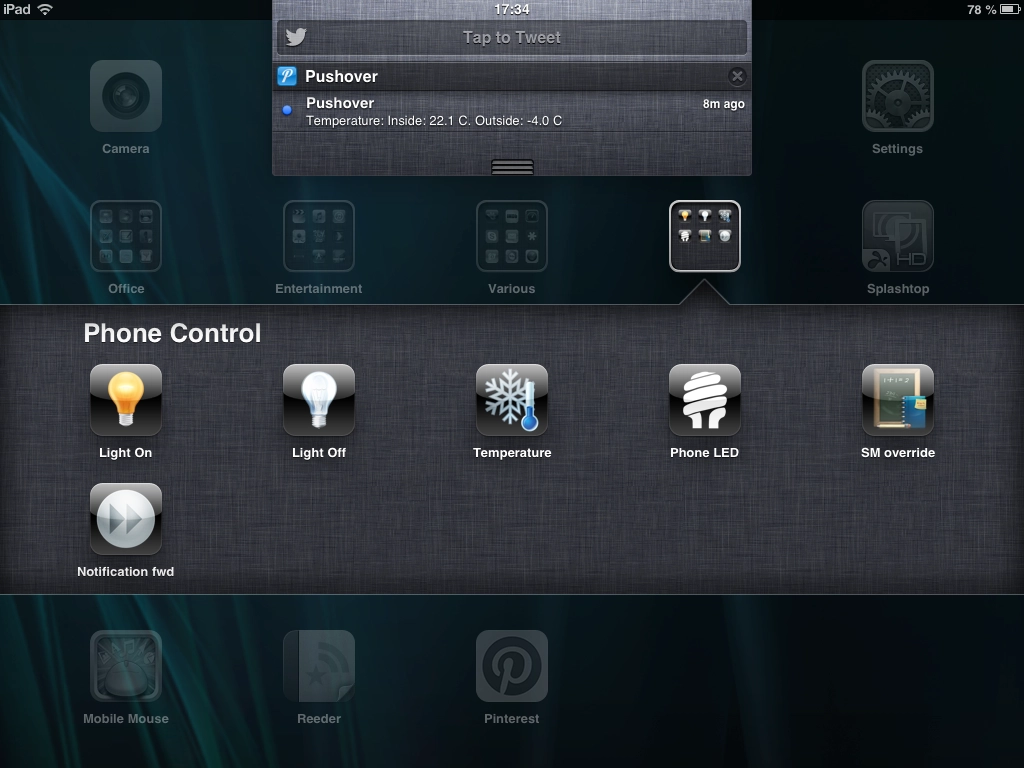How to send push notifications from Tasker on Android to iOS devices

A couple of days ago I wrote about a method for controlling Tasker on Android from home screen shortcuts on iOS. During my further experimentation with that system, I quickly realized that I would need a way to communicate information back to the iOS device as well. I already had a vague idea as to how to do it, as I knew there are apps that allow you to send custom push notifications to iOS devices.
After digging up some old app names I had come across in the past, the choice fell on Pushover, which is a cross-platform notification system that works with both Android and iOS. Despite what you may think though, the cross platform nature of it doesn’t actually play into it in this case, as the methods you can use to send notifications don’t involve any Pushover software on Android- but I’ll get to that.
Essentially, you start by signing up for Pushover, and then install the iOS app. You’re then given two unique codes, one is a key for accessing your Pushover account, and the other is a custom email you can send emails to in order to create notifications that way. Once you have it set up, you can shoot off an email to the given email address to see that it works, if you want.
Now, to actually sending the notifications from Tasker. I actually found three different ways of doing it, each using a different system, and there are probably more. The first thing I tried was to use the Email Me Pro plugin for Tasker to send emails (in the background, automatically) to the Pushover email address. This method supports Tasker variables in messages, it’s fairly reliable, and it’s fairly easy to set up. The downside is that you can’t (as far as I know) control the notification title, which means that each notification will start off with “Email: *your message*” – which can be a bit confusing and unnecessary. It’s also a bit slow, since it goes via an email service, but we’re only talking a 10 second delay or so.
The second method I tried was to use Python for Android, SL4A, and a custom script and task made by this guy. Again it worked well, it runs in the background, and it’s fairly fast. It is, however, also a bit unstable, and the entire SL4A app force closed a couple of times during my testing. On top of that, it’s frankly an unnecessarily complicated way of doing it, especially since it’s only the second most effective way of doing it that I’ve found.
That leads me to the third method, and the method I ended up using. It involves AutoRemote, Zapier, and Pushover. Zapier is a service I’ve tried to avoid talking about, as I don’t much care for their pricing schemes, but ever since AutoRemote was supported by it, it’s become harder and harder to avoid- so I eventually cracked. Zapier is a service that ties together other services on an if this/then that principle, similar to ifttt.com, but with more (smaller) services supported. By sending an AutoRemote message from Tasker to Zapier, Zapier can then filter and transfer it to Pushover, in turn linking the two services. Despite the message going through several services like this, it normally takes only a few seconds from I send a request from my iPad to I receive a notification back. All in all it’s both faster, simpler, and more reliable than the SL4A method, which means I swallowed my pride and started using Zapier. Setting it up includes only a single action in Tasker, and then you set up filters and forwarding in Zapier in a browser, which is fairly well explained as you do it.
The problem with this method is, like I mentioned, Zapier’s pricing scheme. The free service gives you 100 “tasks” each month, which actually means that it will pass on data for you 100 times. You can increase this by doing various jumping though hoops, essentially spamming Zapier to others. However, the real problem comes when you reach the point where you need more than the free service can offer you, as the first step up is a whopping $15/month. We’re talking about a service that moves a few bytes from point A to point B here, which frankly makes Zapier one of the single most overpriced services I have ever seen, similar to the epic fail that is the Arqball Spin. These companies are charging monthly rates that I would hesitate to pay yearly for what they offer, and really make you appreciate what services like Dropbox gives you for the money. Some companies seem to think that they can charge whatever they want for a service just because it’s unique. My general policy is that if I’m not willing to pay the price to upgrade a service to the paid plan if needed, I don’t use the free version either. I hope that the 200 “tasks” I now have with Zapier each month is enough for this two way iOS/Android communication, and it should be, but I’m not happy about using such a service. Luckily, it’s rather easy to switch back to either of the other two methods, should that be necessary.
No matter which of these (or other) methods you use though, this is a fairly neat feature to have, if you use both Android and iOS. The setups I’ve created with this so far includes a Temperature shortcut, which returns a notification with temperature data from my home automation system’s sensors, as well as a Notification Forward shortcut, which forwards the title of the last notification received on the Android device to the iOS device. That way I can quickly checked why my pocket just vibrated when I’m using the iPad.

Download (Pushover): iTunes


